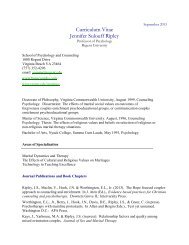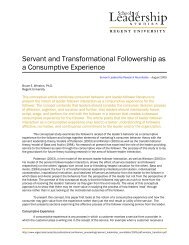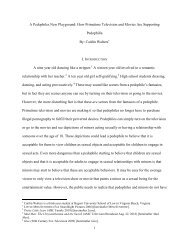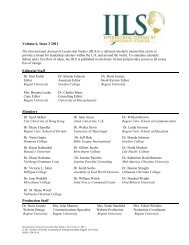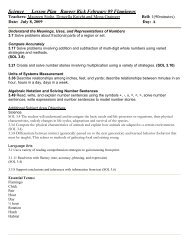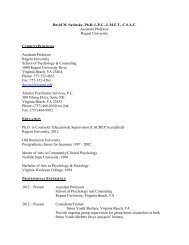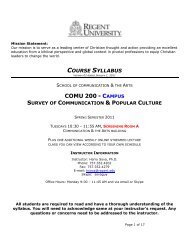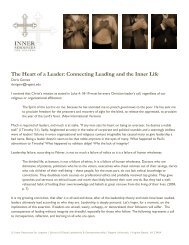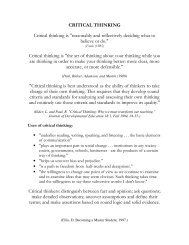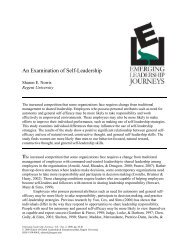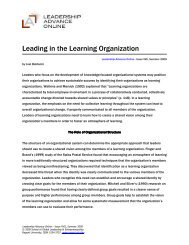Edifying the New Man: Romanian Communist ... - Regent University
Edifying the New Man: Romanian Communist ... - Regent University
Edifying the New Man: Romanian Communist ... - Regent University
Create successful ePaper yourself
Turn your PDF publications into a flip-book with our unique Google optimized e-Paper software.
Bocarnea & Osula/INTERNATIONAL JOURNAL OF LEADERSHIP STUDIES 202<br />
<strong>the</strong> culture. Following <strong>the</strong> Leninist practice, <strong>the</strong> <strong>Romanian</strong> <strong>Communist</strong> mythopoeia was<br />
deliberately focused on social change.<br />
The Myth of <strong>the</strong> <strong>New</strong> <strong>Man</strong><br />
In <strong>the</strong> 1950s, a significant moment in critical studies was <strong>the</strong> shift from rhetoric to myth<br />
analysis. This shift engendered a new species of criticism: myth criticism. Frye (1957) stated that<br />
all stories can be examined not only in terms of <strong>the</strong>ir individual, stylistic, literary qualities but<br />
also in terms of <strong>the</strong> overarching myths that <strong>the</strong>y reincarnate. In our study, analyzing <strong>the</strong><br />
mythopoeia of <strong>the</strong> <strong>New</strong> <strong>Man</strong> in <strong>the</strong> selected doctrinal texts of <strong>the</strong> RCP was a difficult task. The<br />
complex myth found in <strong>the</strong> documents we analyzed was veiled by <strong>the</strong> conceptual, discursive,<br />
propagandistic language of <strong>the</strong> ideologues. Probing beneath <strong>the</strong> outer layers of <strong>the</strong> doctrinal texts<br />
with <strong>the</strong>ir stock Socialist ideology became <strong>the</strong> means whereby we uncovered <strong>the</strong> ideational<br />
concept of <strong>the</strong> <strong>New</strong> <strong>Man</strong>.<br />
Aronoff (1986) considered that one of <strong>the</strong> reasons for <strong>the</strong> strength of a myth is that it<br />
“presents a more lucid and compelling image than do abstract principles. In addition, an account<br />
of <strong>the</strong> past which justifies a present course of action is attractive to most people” (p. 17). In its<br />
simplest form, <strong>the</strong> myth-as-story underscores <strong>the</strong> power of <strong>the</strong> narrative in communicating<br />
meaning and may reveal <strong>the</strong> force of myth creation in all cultural contexts from preschool stories<br />
to media campaigns. As a political myth, <strong>the</strong> myth of a <strong>New</strong> <strong>Man</strong> is built to mobilize collective<br />
action by posing collective responsibilities. The <strong>Romanian</strong> <strong>Communist</strong> mythoplasts selected and<br />
manipulated symbols of <strong>the</strong> traditional culture to recreate a political identity that was both linked<br />
to <strong>the</strong> past and made compatible with <strong>the</strong> political goals of <strong>the</strong> <strong>Communist</strong> future. The formula<br />
was to construct <strong>the</strong> future in <strong>the</strong> present and to deploy <strong>the</strong> myth as an agent of cultural change.<br />
As with all <strong>Communist</strong> myths, <strong>the</strong> <strong>New</strong> <strong>Man</strong> mythopoeia had a strategic appreciation of<br />
time. As <strong>Man</strong>nheim (1936) suggested, in myths “time is always experienced as a series of<br />
strategical points” (p. 244). This <strong>Communist</strong> superman was <strong>the</strong> desired cultural bridge between<br />
Romania’s past and its <strong>Communist</strong> future. It is commonly accepted that every faith and every<br />
state has its own myth (Gorner, 1992). Naturally, <strong>Romanian</strong> overtones of <strong>the</strong> Socialist culture<br />
promoted by <strong>the</strong> state ideologues and mythoplasts became part of <strong>the</strong> myth-making effort. They<br />
became evident at <strong>the</strong> 1976 ideological conference of <strong>the</strong> RCP. For instance, one of its outcomes<br />
was <strong>the</strong> ideological campaign developed around <strong>the</strong> slogan Cantarea Romaniei (Hymn to<br />
Romania). The artistic festival associated with <strong>the</strong> Hymn became <strong>the</strong> potent ritualistic arm of <strong>the</strong><br />
<strong>Communist</strong> mythopoeic effort. The ritual and ceremony of <strong>the</strong> Hymn endowed <strong>the</strong> RCP’s<br />
political actions with a degree of legitimacy warranted by <strong>Romanian</strong> history. As Gilbert (1976)<br />
observed, <strong>the</strong> party was using a “concerted campaign to enhance its image as a national force<br />
which is carrying on <strong>the</strong> traditions of <strong>the</strong> great liberators of <strong>Romanian</strong> history” (p. 304).<br />
According to Highet (1996), myths can be interpreted on <strong>the</strong> basis of three main<br />
principles: “One is to say that <strong>the</strong>y describe single historical facts. The second is to take <strong>the</strong>m as<br />
symbols of permanent philosophical truths. The third is to hold that <strong>the</strong>y are reflections of natural<br />
processes, eternally recurring” (p. 183). Although <strong>the</strong> best mythoplasts seek to create myths that<br />
reflect each of <strong>the</strong>se three principles, <strong>the</strong> reality is that myths are usually less grounded. In that<br />
regard, <strong>the</strong> <strong>New</strong> <strong>Man</strong> was a myth designed mainly to pass <strong>the</strong> <strong>Communist</strong> permanent<br />
philosophical truths on to <strong>the</strong> <strong>Romanian</strong> people.<br />
In <strong>the</strong> next section of <strong>the</strong> paper, <strong>the</strong> texts of <strong>the</strong> RCP doctrinal documents addressing <strong>the</strong><br />
<strong>New</strong> <strong>Man</strong> are deconstructed following <strong>the</strong> definitions and characteristics of myths proposed by<br />
International Journal of Leadership Studies, Vol. 3 Iss. 2, 2008, pp. 198-211<br />
©2008 School of Global Leadership & Entrepreneurship, <strong>Regent</strong> <strong>University</strong><br />
ISSN 1554-3145




